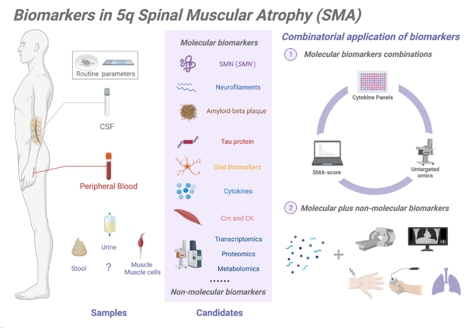NRR:新华医院张健团队综述生物标志物在脊髓性肌萎缩发病机制及药物修正治疗中的作用
撰文:幸小东,刘昕竹,刘艳,张健
脊髓性肌萎缩是一种罕见的遗传性神经肌肉病,属常染色体隐性遗传,其主要发病机制是脊髓前角α运动神经元变性,导致肌肉无力、肌肉萎缩和运动障碍,严重的情况下甚至会影响呼吸和吞咽功能,是2岁以下婴儿的头号遗传病“杀手”[1]。脊髓性肌萎缩的表型十分宽泛,由重到轻可分为0-4型,异质性高,不同表型患者的疾病进展和预后及生存状况存在较大差异[1]。随着脊髓性肌萎缩疾病修正治疗药物的上市,脊髓性肌萎缩已经进入精准治疗的时代,但不同表型患者对药物的反应性和治疗效果均存在不同程度的差异,尤其近年来提出了“个体化治疗”,强调针对个体开展个性化治疗和精细化的评估,需要更方便、更精确、更客观的指标来进一步评估治疗效果。因此,迫切需要寻找理想的生物标志物对患者的疾病严重程度、进展及预后和药物治疗反应等方面进行有效的评估和预测,为患者制定完善的个性化治疗方案和多学科管理策略。近年来,脊髓性肌萎缩生物标志物的研究取得重要进展,但需要指出的是,目前还没有对多种不同类型的脊髓性肌萎缩生物标志物进行全面、系统的总结,也没有对其分类和最新研究进展进行全面的综述。因此,有必要对脊髓性肌萎缩生物标志物领域取得的进展和遇到的挑战进行全面概述。
中国新华医院张健团队在《中国神经再生研究(英文)》(Neural Regeneration Research)上发表了题为“Insights into spinal muscular atrophy from molecular biomarkers”的综述。文章首先讨论了临床实践中常用的监测脊髓性肌萎缩疾病进展或评估药物疗效的方法,同时简要概述它们各自的优缺点,随后又深入探讨了在脊髓性肌萎缩自然病程和药物治疗期间多种不同类型的生物标志物的临床意义和研究进展,从而提供对脊髓性肌萎缩发病机制、生物标志物对药物修正治疗的反应机制、生物标志物候选者的选择以及未来研究发展的新见解(图1)。该综述提示,这些生物标志物将为脊髓性肌萎缩提供新的视角,其成功利用可能成为在整个脊髓性肌萎缩患者的整个生命周期内实施药物修正治疗的关键因素。

图1 5q脊髓性肌萎缩症的生物标志物(图源:Xing et al., Neural Regen Res, 2025)
张健等将生物标志物分为2大类:分别是脊髓性肌萎缩特异性生物标志物和非特异性脊髓性肌萎缩生物标志物。大量证据表明,SMN基因的衍生分子(无论是RNA还是蛋白质)似乎并不适合作为脊髓性肌萎缩疗效评估的生物标志物[2]。在非特异性生物标志物中,神经丝蛋白(neurofilaments, Nfs),既往被认为是神经轴索损伤的强有力标志物,在脊髓性肌萎缩婴儿甚部分脊髓性肌萎缩青少年中显示出很大的潜力,有望作为预后、监测、反应和药效动力学标志物,但在成年和老年脊髓性肌萎缩 患者中应用有限[2];在神经退行性和神经再生标志物中,Tau蛋白在I/II型脊髓性肌萎缩患者中作为药效学评估指标显示出良好的应用前景,但也有研究发现经治疗后Tau蛋白并没有显著变化,因此需要多研究进一步明确[3];在神经炎症相关的标志物中,包括常规脑脊液参数、细胞因子和胶质标志物,如胶质纤维酸性蛋白(GFAP)、几丁质酶1(CHIT1)、几丁质酶3样蛋白1(CHI3L1,又称YKL-40)、钙结合蛋白B(S100B)等,虽然仍处于探索阶段,但脊髓性肌萎缩疾病发展中神经炎症的概念已经得到确立[4]。在肌肉质量和损伤的生物标志物中,由于血清肌酐和肌酸激酶易于获取,可作为常规实验室检查评估疗效及预测预后,但混杂因素较多,不可单独使用[5, 6]。在组学衍生的标志物中,微小RNA不仅可作为脊髓性肌萎缩疾病进展的监测指标,还可为潜在的治疗靶点,但仍需进一步在患者的临床治疗中明确其评估价值及效能[7]。有研究表明:高通量组学数据可揭示脊髓性肌萎缩潜在生物标志物,有助于鉴定对治疗作出反应的患者、追踪疾病进展,并预测临床结果。除此之外,一些非分子生物标志物,如电生理指标、影像学、功能指标等也应用于脊髓性肌萎缩患者的功能监测和评估,将为脊髓性肌萎缩患者开辟潜在的新型治疗和随访途径。
尽管存在许多局限性,但毫无疑问,运动功能评定量表仍然是监测脊髓性肌萎缩进展和评估药物修正治疗效果最具成本效益和易获取的方法。当前,生物标志物的研究已成为热点,不断有新的候选生物标志物被发现,然而,迄今为止,还没有一个单一的生物标志物能够完成脊髓性肌萎缩领域包括诊断、预测、预后、监测、反应和药代动力学在内的所有功能,因此,生物标志物的组合应用,如 “脊髓性肌萎缩分数”、非靶向组学方法、分子标志物加非分子生物标志物的组合,将是未来的研究方向。此外,鉴于疾病修正治疗在脊髓性肌萎缩患者中的广泛应用和终身维持的现状,可预测药物疗效的生物标志物具有最大的实用价值,因此应优先进行调查;再结合神经炎症失调、骨骼肌标志物和多组学特征,可推测脊髓性肌萎缩可能涉及未知的致病机制或疾病修饰因子,这可能导致患者对治疗的反应存在异质性,并值得进一步探索。
原文链接:https://doi.org/10.4103/NRR.NRR-D-24-00067
参考文献
[1] Mercuri E, Sumner CJ, Muntoni F, et al. Spinal muscular atrophy. Nat Rev Dis Primers. 2022;8(1):52.
[2] Lapp HS, Freigang M, Hagenacker T, et al. Biomarkers in 5q-associated spinal muscular atrophy-a narrative review. J Neurol. 2023;270(9):4157-4178.
[3] Šimić G, Vukić V, Babić M, et al. Total tau in cerebrospinal fluid detects treatment responders among spinal muscular atrophy types 1-3 patients treated with nusinersen. CNS Neurosci Ther. 2024;30(3):e14051.
[4] Wood H. Neuroinflammation in spinal muscular atrophy. Nat Rev Neurol. 2023;19(4):197.
[5] Freigang M, Wurster CD, Hagenacker T, et al. Serum creatine kinase and creatinine in adult spinal muscular atrophy under nusinersen treatment. Ann Clin Transl Neurol. 2021;8(5):1049-1063.
[6] Alves CRR, Zhang R, Johnstone AJ, et al. Serum creatinine is a biomarker of progressive denervation in spinal muscular atrophy. Neurology. 2020;94(9):e921-e931.
[7] Chen TH, Chang SH, Wu YF, et al. MiR34 contributes to spinal muscular atrophy and AAV9-mediated delivery of MiR34a ameliorates the motor deficits in SMA mice. Mol Ther Nucleic Acids. 2023;32:144-160.
